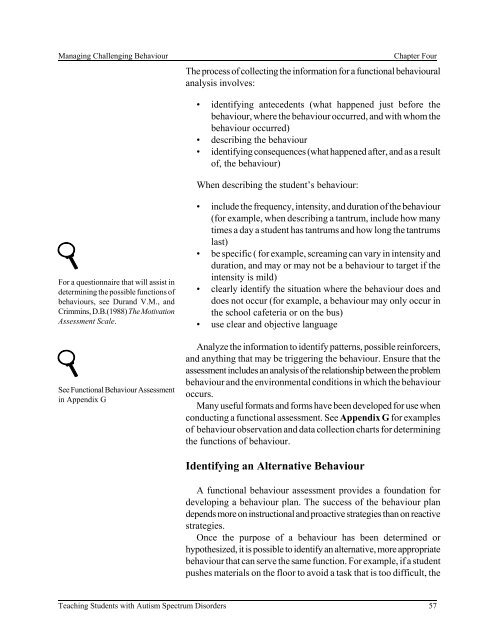Teaching Students with Autism Spectrum Disorders
Teaching Students with Autism Spectrum Disorders
Teaching Students with Autism Spectrum Disorders
You also want an ePaper? Increase the reach of your titles
YUMPU automatically turns print PDFs into web optimized ePapers that Google loves.
Managing Challenging Behaviour Chapter Four<br />
For a questionnaire that will assist in<br />
determining the possible functions of<br />
behaviours, see Durand V.M., and<br />
Crimmins, D.B.(1988) The Motivation<br />
Assessment Scale.<br />
See Functional Behaviour Assessment<br />
in Appendix G<br />
The process of collecting the information for a functional behavioural<br />
analysis involves:<br />
• identifying antecedents (what happened just before the<br />
behaviour, where the behaviour occurred, and <strong>with</strong> whom the<br />
behaviour occurred)<br />
• describing the behaviour<br />
• identifying consequences (what happened after, and as a result<br />
of, the behaviour)<br />
When describing the student’s behaviour:<br />
• include the frequency, intensity, and duration of the behaviour<br />
(for example, when describing a tantrum, include how many<br />
times a day a student has tantrums and how long the tantrums<br />
last)<br />
• be specific ( for example, screaming can vary in intensity and<br />
duration, and may or may not be a behaviour to target if the<br />
intensity is mild)<br />
• clearly identify the situation where the behaviour does and<br />
does not occur (for example, a behaviour may only occur in<br />
the school cafeteria or on the bus)<br />
• use clear and objective language<br />
Analyze the information to identify patterns, possible reinforcers,<br />
and anything that may be triggering the behaviour. Ensure that the<br />
assessment includes an analysis of the relationship between the problem<br />
behaviour and the environmental conditions in which the behaviour<br />
occurs.<br />
Many useful formats and forms have been developed for use when<br />
conducting a functional assessment. See Appendix G for examples<br />
of behaviour observation and data collection charts for determining<br />
the functions of behaviour.<br />
Identifying an Alternative Behaviour<br />
A functional behaviour assessment provides a foundation for<br />
developing a behaviour plan. The success of the behaviour plan<br />
depends more on instructional and proactive strategies than on reactive<br />
strategies.<br />
Once the purpose of a behaviour has been determined or<br />
hypothesized, it is possible to identify an alternative, more appropriate<br />
behaviour that can serve the same function. For example, if a student<br />
pushes materials on the floor to avoid a task that is too difficult, the<br />
<strong>Teaching</strong> <strong>Students</strong> <strong>with</strong> <strong>Autism</strong> <strong>Spectrum</strong> <strong>Disorders</strong> 57

















